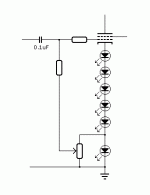Do we equate it to 100Watts per cubic foot for a mono amp? Or, is it capable of more power out if bridged and we have to use a conversion factor from two channel to single channel?
It already contains two Simple P-P boards and each board has its two channels paralleled for twice the power output. I have seen 60 WPC but I think the little EL-84's were on the verge of exploding, even though there was no glow. I had the plate voltage up to 430 volts. It remains to be seen if the thermal management scheme I concocted is capable of removing enough heat, or meltdown occurrs.
Tubes upside down in silicon oil in a "Fry Baby Jr" with the heating element removed and replaced with a 1KW Peltier effect cooler and forced air cooling?
Tubes upside down in silicon oil in a "Fry Baby Jr" with the heating element removed and replaced with a 1KW Peltier effect cooler and forced air cooling?
No, just air, but I am putting a lot of faith in the chimney effect. I will post pictures next time I put it back together. The basic Simple P-P stuff in this amp has been completely reliable at twice the normal power output, but the sand based life forms keep dying. I'm thinking about replacing my simple mosfet screen regulator with a genuine vacuum tube. I was trying to save a few watts of heat, but the fet shorted and fed 430 volts to the EL84 screens. Fortunately this blew the line fuse.
I got some Telux high power LEDs from DK the other day -- I want them to flash our address on the sign-post. I pulled out some Agilents and the Lite-On emitters used in the "Master's Noise" phono pre and here are the impedance statistics:
An externally hosted image should be here but it was not working when we last tested it.
Did you check any possibility of some type being noisier than others? Signal level is high there, but just out of curiosity. Maybe to know for biasing in other, like in front end circuits.
The Agilents' have been hanging around here for 8 or 9 years so I don't know if the successor company (Avago) devices are less noisy. Telux looks interesting for the front end of a preamp:
An externally hosted image should be here but it was not working when we last tested it.
Interesting. There are big enough differences. Are those scans for a single LED per brand/type?
I only did the analysis after your inquiry -- so it's only one sample. It is interesting that all the Avago's bunch at one end. I didn't use the precise LT1990 current generator, just a 221 ohm 1/2 watt rez to limit the current.
RDL - motorboating after having connected feedback
Hi,
I have rewired RDL and also changed OPT in my RDL. After reconnecting feedback the amp starts motorboating, LEDs start flashing. While disconnected sound is OK. The same occurs when I change OPT terminal as a fb source.
Any hint where to start with diagnostics?
Hi,
I have rewired RDL and also changed OPT in my RDL. After reconnecting feedback the amp starts motorboating, LEDs start flashing. While disconnected sound is OK. The same occurs when I change OPT terminal as a fb source.
Any hint where to start with diagnostics?
Sounds like the feedback is positive. Try reversing the plate to transformer primary connections.
Did I mention I had reversed feedback to secondaries' terminal connection? The same motorboating sound. Secondaries floats.
did you connect one side of the secondary winding to ground?
what i do in case of motorboaring is to swap the primary plate leads instead.......
what i do in case of motorboaring is to swap the primary plate leads instead.......
That's interesting. Can you (with feedback disconnected) do a voltage map? I'd also double check the wiring around the screens and screen regs, especially the grounding.
edit: Just noticed the "secondaries float" comment. Like Tony pointed out, one side of the secondary must be grounded (run a wire back to the input stage ground point at the bottom of the cathode resistor). Then check with both polarities of the primary.
edit: Just noticed the "secondaries float" comment. Like Tony pointed out, one side of the secondary must be grounded (run a wire back to the input stage ground point at the bottom of the cathode resistor). Then check with both polarities of the primary.
Then there are 2 things:
- ground one terminal of each secondary - forgot about it while rewiring.
- reverse (or not) plates to OPT primary.
Need to check in the evening.
Thanks SY and Tony,
- ground one terminal of each secondary - forgot about it while rewiring.
- reverse (or not) plates to OPT primary.
Need to check in the evening.
Thanks SY and Tony,
what i do with my amp build is to wire up the secondary side first......the plate leads are soldered lightly to tube pins....
there is a 50-50 chance you'd get it at first go....so that in case of motorboating, i simply reverse the plate leads, dressing it up and cutting for final soldering to tube pins....
there is a 50-50 chance you'd get it at first go....so that in case of motorboating, i simply reverse the plate leads, dressing it up and cutting for final soldering to tube pins....
AFAIR SY wrote about drinking wine in one of articles. I guess I read the same chapter to many times and followed *that* instructions strictly and forgot to check things. 😀
- Home
- Amplifiers
- Tubes / Valves
- The Red Light District - another PP EL84 amp
